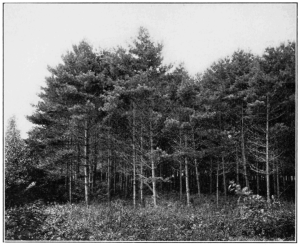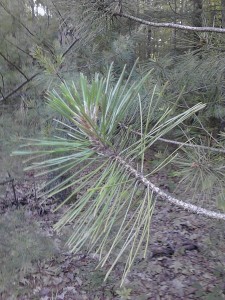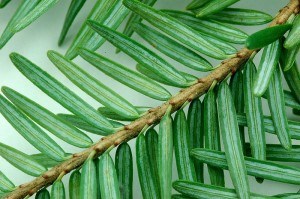Background information on pine trees and other conifers
Although many people commonly call all evergreen trees with needles “pine trees,” pines only make up one genus of conifers; the conifers, however, make up the order called Pinales, so some confusion is understandable. Conifers are by far the largest group of gymnosperms, which are one of the two broad classifications of seed plants. The other group, the angiosperms, produce seed that is enclosed in a fleshy covering, but gymnosperms produce uncovered seed—the name gymnosperm actually means “naked seed.” What sets conifers apart from the few other types of gymnosperms is the cone (cone-ifer—get it?) that conifers produce to protect the seed. Cones are often referred to as pine cones regardless of what tree they come from, but, again, there are plenty of conifers other than pines (Oxford, 2015; Wikipedia, 2015).
There are over 600 species of conifers throughout the world, including pine, of course, and also spruce, redwood, juniper, and fir, among others (Oxford, 2015). The great majority of conifers in temperate regions are in two families. One of these families, Cupressaceae, includes cypresses, junipers, Thuja spp. (also known as arborvitae or New World cedars) and the Sequoia spp.; Sequoia includes both the giant sequoia, the largest tree on earth, and the redwood, which is the tallest. The other family is—wait for it—Pinaceae, which includes pines (surprise!), true cedars, firs, spruces, and hemlocks (Wikipedia, 2015).
How to tell the difference between pines, spruces, firs, and hemlocks
An easy way to tell the difference between some of the common types of evergreen conifers (pine, spruce, fir, and hemlock) is to look at the needles and the way they attach to the branches of the tree. Pine needles grow in bundles of two, three, or five needles. If there are two, it is in the red pine group; three, yellow pines; five, white pines (Iowa State, 2005) :
Fir, spruce, and hemlock needles grow individually on the tree’s branches. The needles of spruce trees are kind of square and can be rolled between the fingers. Fir and hemlock needles won’t roll because they are flattened. Firs and hemlocks can be a little bit trickier to distinguish, but hemlock needles grow on a little stem, while fir needles grow right out of the branch (Michigan State, n.d.):
The eastern white pine
Anyway, back to pine trees. The cleverly named genus Pinus contains about 115 species of pine trees. These include the world’s oldest tree, a nearly 5,000 year old bristlecone pine in California called Methuselah (PBS, 2001). Only about six species of pine are native to the Mid-Atlantic region of the United States: the eastern white pine, pitch pine, red pine, shortleaf pine, table-mountain pine, and Virginia pine (Weller, n.d.).
The eastern white pine, Pinus strobus, is the tallest pine in eastern North America, and this factor made it one of the most economically important trees in colonial America. As early as the 1600s, eastern white pine was extensively logged to use for ship masts for the Royal Navy. The tree, which grew extensively in New England, the Appalachians, and the Great Lakes region, was also widely used for building houses and furniture, so very few of the original stands of eastern white pine remain today (Earle, 2015).
Growing eastern white pine from seeds
Propagation of pine trees from cuttings is possible and is performed successfully in controlled greenhouse conditions, and grafting other pine species onto eastern white pine rootstock is sometimes done commercially, but a more common and much easier method of propagation is by seeds. The seeds of many pine species can be planted immediately, but some, including the eastern white pine, must be “stratified,” or chilled, to bring the embryo out of dormancy prior to planting (Hartmann & Kester, 2011).
To get eastern white pine seeds, you have two options. The first is to simply buy seeds. A quick internet search will turn up plenty of nurseries that will gladly sell them to you. The other option is to collect the seeds yourself. If you want to do this, identify a white pine you would like to propagate and wait until the female cones are ripe in the fall. When the cones are ripe some of them begin to fall from the trees, so you can just pick them up off the ground; most of the cones that are still on the tree will be too high to reach, but if you can get to them these will be more likely to have viable seeds. Look for cones that haven’t opened up completely, since the fully opened ones will probably have dispersed all of their seeds. You will need to collect a lot of cones to get a few viable seeds. Fill up a bag with them, and over the course of the next few days or weeks, shake the bag; as the cones dry out, they open up and the seeds will fall out into the bag (Phipps, 2015).
After you have a bunch of seeds, put them in a container of water overnight. Discard the seeds that float, and the remainder should be viable. Put them in your refrigerator for at least two months to break their dormancy (Wendel & Smith, 1990). After chilling, plant the seeds in individual pots filled with potting mix, and keep the mix moist. It will take several months for the seeds to germinate. After the plants grow to at least 6 inches tall, they can be transplanted outside (Phipps, 2015). Eastern white pines grow quickly, and after 20 years of growth they can achieve a height of 40 feet (Weller, n.d.). Good luck!
Sources
Earle, C. J. (2015). Pinus strobis. The gymnosperm database. Retrieved from http://www.conifers.org/pi/Pinus_strobus.php
Hartmann, H. T., Kester, D. E., Davies Jr., F. T., Geneve, R. L. (2011). Rhododendronspp. Hartmann & Kester’s Plant Propagation Principles and Practices (8th ed.). Upper Saddle River, NJ: Pearson Education.
Iowa State University, University Extension (2005). Pine, fir, or spruce tree? Extension news. Retrieved from https://www.extension.iastate.edu/news/2005/nov/061401.htm
Michigan State University Extension (n.d.). Flat-needled conifers. U.P. tree identification key. Retrieved from http://uptreeid.com/Species/flatneedles.htm
Phipps, N. (2015). Learn how to grow a pine tree from seed. Gardening know how. Retrieved from http://www.gardeningknowhow.com/ornamental/trees/pine/how-to-grow-a-pine-tree-from-seed.htm
Public Broadcasting Service (2001). Methuselah tree. Nova online. Retrieved from http://www.pbs.org/wgbh/nova/methuselah/
University of Oxford, Department of Plant Sciences (2015). Conifer distribution. Conifers of the world: Resources for conifer research. Retrieved from http://herbaria.plants.ox.ac.uk/bol/conifers
Weller, R. (n.d.). Pine trees of Pennsylvania. TreesForMe. Retrieved from http://www.treesforme.com/pa_pinus.html
Wendel, G. W. & Smith, H. C. (1990). Pinus strobus L.: Eastern white pine. In Sylvics of North America. Retrieved from http://www.na.fs.fed.us/pubs/silvics_manual/Volume_1/pinus/strobus.htm
Wikipedia contributors (2015). Pinaceae. Wikipedia, the free encyclopedia. Retrieved from http://en.wikipedia.org/wiki/Pinaceae







